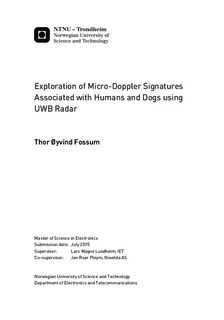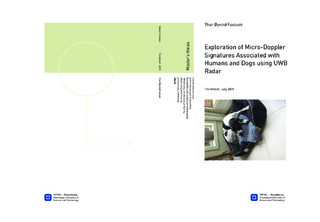| dc.description.abstract | The work in this thesis has been a part of the task of using a radar to separate between humans and animals in a alarm and surveillance context. For the radar to be able to separate between humans and animals it would use a classifier that rely on features extracted from the radar data. The thesis considers two types of targets; either a human or a dog, and by using micro-Doppler signature, determines some fundamen- tal features which can be the used to classify them. The micro-Doppler signature is the superposition of frequency modulations represented in the joint time and Doppler frequency domain, where the modulations are caused by dierent moving components associated with the desired target. The micro-Doppler signature has been widely used for radar classification.
The thesis has succeeded in developing algorithms and a system to extract micro- Doppler signatures from targets. Signatures from both humans and dogs has been produced and some simple features extracted from them. The major problem with the signatures created is that the radars pulse repetition frequency is a limiting factor and causes aliasing in the Doppler spectrum that corrupts the signatures. This has limited the study of targets to slow moving humans and dogs.
Three important features for classification was extracted from the micro-Doppler signature by calculating the gait-Doppler map. They are, i) the average Doppler fre- quency fav(or average radial velocity vav), ii) fundamental gait frequency fg and iii) the stride length Ls which is derived from the two former features.
The result points towards the possibility to separate humans and dogs using these parameters. The reason is that since the dogs limbs are shorter than a human it also has shorter stride length at a specific speed. However, this may not be sucient for decisions to be made in a robust alarm system, since it can be fooled by a smart intruder that could for example take unnatural short steps and simulate a dogs combination of the aforementioned features.
In addition the determination of features are sensitive to large changes in radial speed. This can be mitigated by preprossing before the calculation of the features.
The conclusion is, that based on substantial measurements of signatures ( approx. 50 series) and calculations of the three features one has arrived at a fairly robust method to distinguish between the two type of target in this thesis. | |

